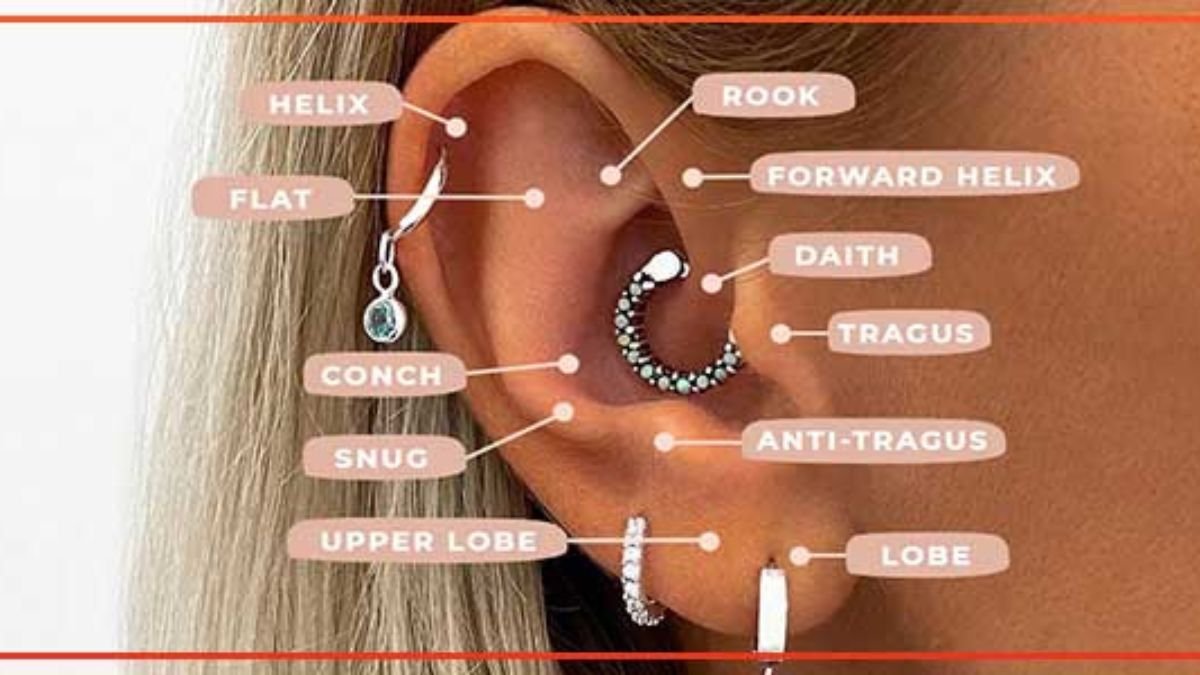Are you ready to elevate your ear game? Ear piercings have been a popular form of self-expression for centuries, and with so many different options available, it’s time to dive headfirst into the world of ear adornment. From simple lobe piercings to intricate helix arrangements, there’s something for everyone on this exciting journey.
In this comprehensive guide, we’ll explore an array of ear piercing options and delve into the depths of each one. But that’s not all – we’ll also uncover the mystery behind an ear piercing chart, discuss the pain factor involved in getting pierced, reveal healing timelines, shed light on multiple piercings in a single session, and even touch upon which gemstones make the best earrings.
So grab your favorite pair of earrings (or get ready to shop for some new ones) as we embark on a fascinating exploration of different ear piercings. Let’s dive right in!
Table of Contents
Types of Ear Piercings
Ear piercings come in a wide variety, each offering its own unique style and statement. Starting with the classic lobe piercing, which is the most common and versatile option. Moving on to the transverse lobe piercing that adds an edgy twist by horizontally piercing through the earlobe.
For those seeking a more unconventional look, there’s the snug piercing that hugs the inner cartilage of your ear snugly. The rook piercing sits right above it, adding a touch of elegance to your ear game. And if you’re looking for something bold and attention-grabbing, why not try an industrial piercing? This daring choice involves connecting two piercings in the upper cartilage with a barbell or other jewelry. With so many options available, there’s no limit to how creative you can get with your ear piercings!
Lobe Piercing
Lobe Piercing is the most common and popular type of ear piercing. It involves creating a small hole in the fleshy part of the earlobe and inserting an earring. This type of piercing is relatively painless and heals quickly, making it perfect for first-timers or those who prefer a more subtle look.
With lobe piercings, you have endless options when it comes to earrings. From simple studs to statement hoops, you can easily switch up your style based on your mood or outfit. Plus, since the lobe area has a good blood supply, healing time is usually around 4-6 weeks – so you’ll be rocking new earrings in no time! So whether you want to go classic with gold or silver studs or get creative with colorful gems or trendy shapes, lobe piercings offer endless possibilities for self-expression.
Transverse Lobe Piercing
The transverse lobe piercing is a unique and eye-catching ear piercing that adds an edgy twist to your look. Unlike traditional lobe piercings, which go straight through the fleshy part of the earlobe, the transverse lobe piercing runs horizontally across the earlobe. This placement allows for a striking and unconventional appearance.
With its horizontal orientation, this piercing can be adorned with various types of jewelry such as barbells or rings. The choice is yours! Whether you opt for a sleek and minimalist style or want to make a bold statement with colorful gemstones or intricate designs, the transverse lobe piercing offers endless possibilities for personalization.
By breaking away from tradition and embracing this modern trend in ear piercings, you can showcase your individuality and express your unique sense of style. So if you’re ready to step outside the box and try something different, consider getting a transverse lobe piercing – it’s sure to turn heads!
Snug Piercing
The snug piercing is a unique and stylish option for those looking to add some edge to their ear jewelry collection. This type of piercing goes through the inner cartilage fold of the ear, creating an eye-catching look that can be adorned with various types of earrings.
One thing to keep in mind is that the snug piercing requires careful placement by a professional piercer, as it needs to align perfectly with your anatomy. It may also take longer to heal compared to other ear piercings due to its location in the cartilage. Despite this, many people find the snug piercing well worth it for its striking appearance and ability to showcase different earring styles. So if you’re looking for something a little different, consider getting a snug piercing and rock your own unique style!
Rook Piercing
The rook piercing is a unique and stylish ear piercing that has gained popularity in recent years. Located on the inner cartilage fold of the ear, this piercing adds an edgy touch to your overall look.
To get a rook piercing, a professional piercer will use a needle to create a small hole in the thick cartilage of the rook area. The jewelry typically used for this type of piercing is usually a curved barbell or captive bead ring, which enhances its aesthetic appeal.
With proper care and cleaning, the healing process for a rook piercing can take anywhere from 6 to 12 months. It’s important to avoid touching or twisting the jewelry during this time to prevent irritation or infection. If you’re considering getting a rook piercing, make sure to consult with an experienced piercer who can provide guidance and ensure it’s done safely and accurately.
Remember, everyone’s pain tolerance varies when it comes to piercings, so what may be uncomfortable for one person might not be as painful for another. Nonetheless, if you have any concerns about pain levels during your rook piercing experience, don’t hesitate to discuss them with your chosen piercer beforehand
Industrial Piercing
The industrial piercing is a bold and eye-catching choice for those looking to make a statement with their ear jewelry. This unique piercing involves two holes connected by a single barbell, creating an edgy and modern look.
One hole is typically placed in the upper cartilage of the ear, while the other is positioned closer to the lobe. The barbell then runs horizontally through both holes, giving the illusion of one continuous piece. It’s important to note that this piercing requires some patience during healing due to its placement in cartilage, but once healed, it’s definitely worth the wait! So if you’re ready to step up your ear game and embrace an edgy aesthetic, consider getting an industrial piercing.
Conch Piercing
The conch piercing is a unique and stylish choice for those looking to add some edge to their ear jewelry collection. Located in the inner cartilage of the ear, this piercing can be done on either the outer or inner conch.
With its versatility, you have various options for jewelry placement and design. You can opt for a simple stud or hoop, or explore more intricate options like barbells or captive bead rings. The conch piercing offers endless possibilities for expressing your personal style and adding a bold statement to your overall look.
Tragus Piercing
The tragus piercing is a popular choice for those looking to add some edge to their ear jewelry collection. Located on the inner cartilage of the ear, this piercing adds a unique and stylish touch.
One of the great things about tragus piercings is that they can be easily personalized with different types of jewelry, from delicate studs to intricate hoops. Plus, since it’s tucked away in your ear, it offers a subtle yet eye-catching look. So if you’re looking for a trendy and versatile ear piercing option, consider giving the tragus piercing a try!
Daith Piercing
Daith piercing is a unique and stylish option for those looking to add some flair to their ear. This type of piercing goes through the innermost cartilage fold, creating an eye-catching look. The daith piercing has become increasingly popular in recent years due to its placement and aesthetic appeal.
One reason why people choose daith piercings is because they can be easily accessorized with different types of jewelry, such as hoops or studs. The small size and location of the daith piercing also make it relatively easy to care for compared to other more complex ear piercings. Whether you’re going for a simple and minimalistic look or want something more intricate, the daith piercing offers endless possibilities when it comes to expressing your personal style.
Helix Piercing
Helix Piercing, also known as the cartilage piercing, is one of the most popular ear piercings today. It involves puncturing the upper rim of the ear, creating a stylish and edgy look.
Many people opt for helix piercings because they can be adorned with various types of jewelry, such as studs or hoops. The process itself may cause some discomfort due to the thickness of the cartilage, but it is generally well-tolerated. Aftercare is crucial for proper healing and avoiding infection.
Helix piercings are an excellent way to express your individuality and add a touch of personal style to your appearance! So if you’re thinking about getting one, make sure to consult with a professional piercer who can guide you through the process and ensure you achieve that perfect helix piercing!
Forward Helix Piercing
The forward helix piercing has gained popularity in recent years, giving a unique and edgy look to the ear. This type of piercing is done on the upper cartilage of the ear, slightly above the tragus.
With its placement at the front of the ear, it creates a striking and eye-catching effect. Many people opt for multiple forward helix piercings to create a more intricate and personalized design. The healing process for this piercing can take anywhere from 6 to 12 months, depending on individual factors such as aftercare and body’s natural healing ability.
Orbital Piercing
A Unique Twist to Ear Decor
The orbital piercing is a fascinating and eye-catching choice for those seeking something different. This type of piercing involves two punctures connected by a single piece of jewelry, creating the illusion of an orbit around the ear. It can be done on various parts of the ear, such as the helix or conch.
With its captivating design, the orbital piercing allows for endless possibilities when it comes to selecting jewelry. From simple hoops to elaborate studs, you can find a style that suits your personal taste and adds an edgy touch to your look.
One important thing to note is that healing time may vary depending on the specific location of your orbital piercing and how well you care for it. Be sure to follow proper aftercare instructions provided by your piercer to ensure a smooth healing process. So if you’re looking for a unique way to showcase your individuality, consider getting an orbital piercing – it’s sure to turn heads!
Cartilage Piercing
Cartilage piercings have gained immense popularity in recent years, and it’s easy to see why. This type of piercing involves the outer rim of your ear, creating a unique and edgy look. Whether you opt for a simple stud or want to go all out with multiple hoops, cartilage piercings offer endless possibilities for self-expression.
One of the advantages of cartilage piercings is that they can be placed in various locations along the ear. From helix piercings at the top to conch piercings deeper within the cartilage, there are plenty of options to choose from. Just keep in mind that cartilage is thicker than lobe tissue, so healing may take longer and require more care. But don’t worry – with proper aftercare and patience, you’ll be rocking your stylish new accessory in no time!
What is an Ear Piercing Chart?
An ear piercing chart is a visual guide that showcases the different types of ear piercings available. It provides information on where each piercing is located, how it’s done, and what kind of jewelry can be worn in that specific area.
These charts are incredibly helpful for individuals who want to explore various options and decide which type of ear piercing suits them best. They allow you to see all the possibilities at a glance, making it easier to make an informed decision about your desired look. So whether you’re interested in a simple lobe piercing or something more adventurous like an industrial or conch piercing, consulting an ear piercing chart can help you visualize the options available to you!
Which Ear Piercings Hurt the Most?
So, you’re thinking about getting an ear piercing but wondering which ones hurt the most? Well, let’s dive right into it. When it comes to pain levels, everyone’s tolerance is different, and what might be painful for one person may not be as intense for another.
That being said, there are a few piercings that tend to be known for causing more discomfort. One of these is the daith piercing, which goes through the innermost cartilage fold of your ear. Another piercing that can elicit some pain is the rook piercing, located in the ridge between your helix and inner conch. Keep in mind that while these piercings may cause some initial discomfort during the process itself, with proper aftercare they typically heal relatively quickly.
Remember that pain is subjective and temporary – if you really want a particular ear piercing style or placement, don’t let fear hold you back!
So what is the most painful ear piercing?
When it comes to ear piercings, one of the questions that often arises is: which piercing hurts the most? The answer may vary depending on individual pain tolerance and sensitivity. Some people claim that cartilage piercings, such as rook or industrial piercings, can be more painful due to the denseness of the cartilage tissue. On the other hand, others argue that daith or tragus piercings can be equally intense due to their location close to nerve endings.
While there isn’t a definitive answer as to which ear piercing is the most painful, it’s important to keep in mind that everyone’s experience will differ. It’s crucial to choose an experienced and professional piercer who can provide guidance throughout the process and minimize any discomfort. Remember, pain is subjective and temporary; with proper care and aftercare routines, you’ll soon be able to enjoy your stylish new ear jewelry!
How Long Does it Take for a Pierced Ear to Heal?
One of the most common questions people have after getting a new ear piercing is how long it will take to heal. The healing time can vary depending on the type of piercing and individual factors such as healing ability and aftercare practices.
In general, lobe piercings tend to heal relatively quickly, usually within 6-8 weeks. However, cartilage piercings take longer to heal due to their location and thicker tissue. It can take anywhere from 4 months to a year for a cartilage piercing to fully heal. It’s important to follow proper aftercare instructions during this time period to ensure optimal healing and minimize the risk of infection or complications.
How Many Piercings Can I Have in a Single Session?
When it comes to getting multiple ear piercings, many people wonder how many they can actually get in one session. The answer may vary depending on the individual and their pain tolerance, as well as the expertise of the piercer.
Generally speaking, most professional piercers will recommend getting no more than 3-4 piercings in a single session. This allows for proper healing time and reduces the risk of infection or complications. However, some people may be able to tolerate more piercings at once if they have experience with previous ones and are comfortable with the process.
It’s important to consult with your piercer beforehand to discuss your desired number of piercings and determine what is feasible based on your specific circumstances. Remember, quality should always take precedence over quantity when it comes to body modifications like ear piercing!
What Gemstones Make the Best Earrings?
Choosing the right gemstones for your earrings can add a touch of elegance and personal style to your ear piercings. There are numerous options available when it comes to gemstone earrings, each with its own unique beauty and symbolism.
Diamonds are often considered the most classic and luxurious choice for earrings. They symbolize strength, purity, and eternal love. If you’re looking for a timeless and sophisticated look, diamond earrings are an excellent option.
For those seeking vibrant colors, rubies can make a bold statement. These fiery red gemstones represent passion, courage, and prosperity. Whether set in gold or silver, ruby earrings can add a pop of color that catches everyone’s attention.
Sapphires come in various shades of blue but also occur in other colors like pink and yellow. Known as the stone of wisdom and royalty, sapphire earrings can bring sophistication to any outfit while conveying a sense of inner peace.
Emeralds have long been associated with rebirth and renewal due to their lush green hue. Wearing emerald earrings not only adds an elegant touch but also represents hope, growth, and fertility.
If you prefer something more whimsical or bohemian-inspired, opal earrings may be perfect for you. Opals display stunning iridescent hues that change depending on the angle viewed under light. These mystical stones symbolize inspiration, creativity,and emotional freedom.
Pearls offer timeless elegance combined with natural beauty. Perfectly suited for both formal occasions or casual wear pearl studs give off an air of refined simplicity while representing purityand femininity
Ultimately,the best gemstone earring is one that speaks to your individual taste,symbolizes something meaningful,and complements your overall style.
Whether you choose diamonds,rubies,sapphires,popular birthstones or another precious stone altogether.
The important thing is finding what resonates with you personally.





